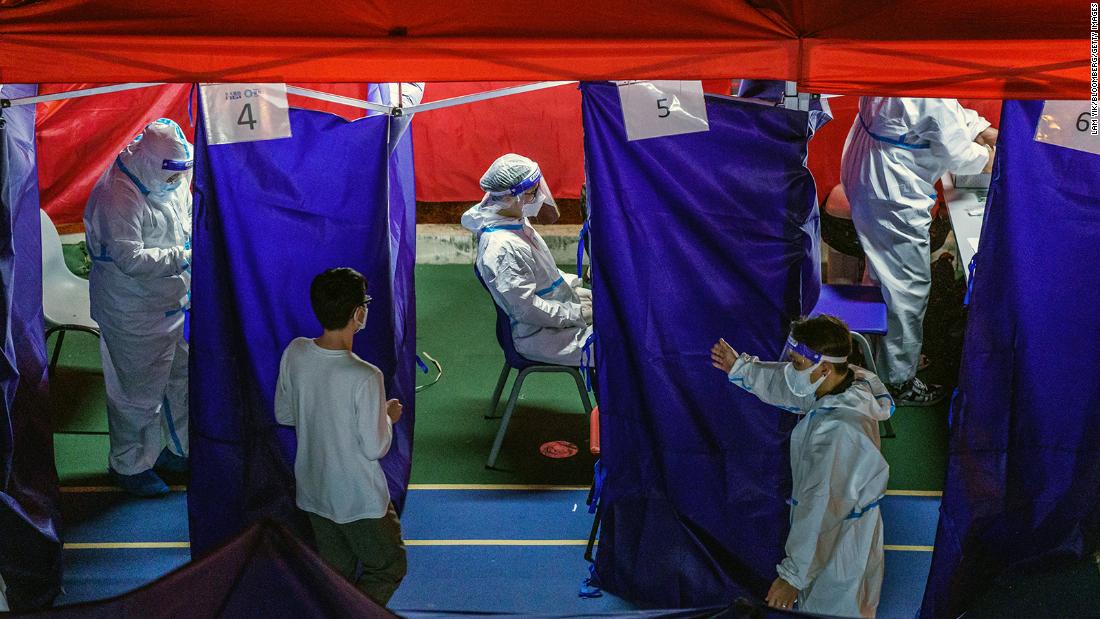
As BA.2 grows in the US, experts look to other countries to predict its impact here

CNN —
After weeks in free fall, new Covid-19 cases are starting to level off in the US, as the BA.2 subvariant continues its ascent.
BA.2 caused about 35% of cases in the US last week, up from 22% the week before, according to new estimates from the United States Centers for Disease Control and Prevention, which were posted on Tuesday.
At the same time, new Covid-19 cases are holding steady or increasing in about 19 states, according to data from Johns Hopkins University.
Some of the states seeing increases—New York, New Hampshire, Massachusetts, Vermont, and New Jersey are in northeastern regions where the CDC estimates that BA.2 is now causing more than half of new Covid-19 cases.
Health officials have warned that overall Covid-19 infections could rise across the US in a few weeks, parallel to trends in the UK and Europe.
“I would not be surprised at all if we do see somewhat of an uptick,” Dr. Anthony Fauci, director of the National Institute of Allergy and Infectious Diseases, said in a live interview on Tuesday with the Washington Post. “I don’t really see, unless something changes dramatically, that there will be a major surge,” he said.
In the UK, where BA.2 now accounts for 85% of new infections, cases have increased by 20% week-over-week. Hospitalizations are up about 22% compared to the prior week. Deaths recorded within 28 days of a positive Covid-19 test are up about 17%, according to the most recent government numbers.
On Tuesday, the University of Washington’s Institute of Health Metrics and Evaluation, said their model does not predict a new surge in Covid-19 cases “similar to what we have seen in parts of Europe,” said Ali Mokdad, a professor of global health at IHME, on Twitter. Instead, he said, their models suggests that after the end of March there would be a steady further decline in Covld-19 transmission in the US.
BA.2 is technically classified as a part of the Omicron family of viruses, but genetically this strain is very different, with about 40 mutations separating it from its cousin, BA.1. That makes it about as distinct from the original Omicron as Alpha, Beta, and Delta were from each other.
It is more contagious than Omicron’s BA.1, which was already an extremely contagious virus with a basic reproduction number, or R-naught, of about 8, according to William Hanage, an epidemiologist at Harvard’s T.H. Chan School of Public Health, which means that a single infected person could be expected to transmit the disease to an average of 8 others.
Adrian Esterman, an epidemiologist at the University of South Australia, pegged the basic reproduction number for BA.2 at around 12. “That makes it pretty close to measles, the most contagious disease we know about,” he wrote on Twitter on March 10.
Though BA.2 is more contagious, it does not appear to cause more severe disease. And though it escapes some of the immune protection created by vaccinations and prior infections, it doesn’t seem to do so any more than BA.1.
Hanage says that at a population level, Omicron is much more manageable than Delta was, but it is not harmless.
“The reason why Omicron BA.2 and BA.1 are a problem at all are the sheer numbers of infections they cause,” Hanage said.
The contours of the BA.2 wave have looked very different in different countries. BA.2 has caused a spike in cases and deaths in Hong Kong, where many seniors were hesitant to be vaccinated, but in South Africa, where it arrived on the heels of that’s country’s large BA.1 surge, it barely made a ripple—causing cases to plateau rather than climb.
What the BA.2 may do in the US remains an open question.
The UK has offered some clues to the trajectory of variants in the past. But there are key differences.
Working in their favor, the UK is more highly vaccinated than the US. Among those ages 12 and older, 86% of the population has had two doses of a vaccine, while more than two-thirds have gotten a third or booster dose. In the US, 74% individuals ages 12 and older have had two doses of a vaccine, but just 46% have had a booster.
But the UK has its own challenges, too, says Dr. Carlos Del Rio, an infectious disease specialist and executive associated dean at the Emory School of Medicine. “They have a much, much older population than we do,” he says.
In the UK, 19% people are over the age of 65, according to a UK government report. In the US, seniors make up about 16% of the population.
Del Rio says that while it wasn’t much fun at the time, “The good news is that we got a huge Omicron surge in the US. Millions of people were infected,” he says.
“And between the number of people infected and the number of people who were already vaccinated, we estimate that about 73% to 75% of the population has some degree of immunity,” he says.
Leaving about 25% of Americans vulnerable to the BA.2 virus either because they couldn’t or didn’t make antibodies.
“So my guess is that we’re going to have a surge, but it’s not going to be a severe surge,” Del Rio says, though he’s still worried about the 25% of Americans that aren’t protected.
Other intriguing clues about the shape of a BA.2 wave come from the Middle Eastern country of Qatar, which has used roughly the same mix of vaccines as the U.S.
Qatar has been living with BA.2 as it’s dominant virus since Christmas. They also saw a large Omicron surge that peaked around mid-January, followed by a sharp decline in cases.
In a string of recent studies, Laith Abu-Raddad and his co-authors at Qatar’s Weill Cornell University, have been estimating the protection conferred by mRNA vaccines as well as by previous infections.
What they found is that two doses of the mRNA vaccines offer moderate protection against symptoms—in the range of 36% to 50%. But that protection only lasted for about four months. After four months, the protection became negligible, and after seven months, their studies found that vaccinated people were actually a bit more likely to get sick than unvaccinated people, perhaps because they had a false sense of security.
“Vaccinated people don’t behave the same ways as unvaccinated. You know, they think they are protected, so this could expose them,” Abu-Raddad said.
Even though protection against infections faded pretty dramatically over time, people who were vaccinated continued to have good protection against hospitalizations and deaths, in the rage of 70% to 80%, he said, and it jumped to around 90% with a booster.
“The best thing anyone can do right now is to get a booster,” Abu-Raddad said. “Boosters bring back the protection against infection to what it used to be about 60%, which is great,” even though it wanes over time, he said. “But really the amazing thing about booster effectiveness is that it virtually eliminates the risk of Covid-19 hospitalization and death,” he added.
In a separate study, Abu-Raddad and his team also looked at protection of a BA.1 infection against BA.2. That protection was even stronger and more durable than two shots of an mRNA vaccine, in the range of 90%, he said.
“So that is actually another reason to think that even if there will be a wave, it’s not going to really be as bad as people may fear,” he said.
Immunity after infection wanes much more slowly, he says. In a new study, where they followed people who were infected with Alpha and Beta variants, they still had 50% protection against Omicron reinfection up to a year later.
Abu-Raddad thinks that the difference is that immunity created by an infection remains in the tissues of the mouth and nose, while antibodies created by vaccination rise body-wide don’t stay elevated for as long in these tissues that first encounter the virus.
One thing Abu-Raddad’s research can’t reveal is how well immunity holds up for older people. Qatar is a young country. Less than 10% of the population are over the age of 50, he says, so they couldn’t tell if the vaccines continued to work as well for seniors as they did for younger people.
Del Rio suspects that the vaccine efficacy in seniors wanes farther and faster than it does for younger people.
“I predict the CDC in the next week or two is going to recommend a fourth dose for people over 65. If you’re 65, and you get infected, you could still have very severe disease despite being vaccinated,” he said.
Source: https://www.cnn.com/2022/03/22/health/ba-2-wave-us-other-countries/index.html

















